Nymphiya Blue, white and dark pink water lilies (3 plants)
Original price was: ₹2000.₹899Current price is: ₹899.
Description
In India, we can sell Nymphiya Blue, white and dark pink water lilies (3 plants) via online delivery systems to any states including Andhra Pradesh, Arunachal Pradesh, Assam, Bihar, Chhattisgarh, Goa, Gujarat, Haryana, Himachal Pradesh, Jammu & Kashmir, Jharkhand, Karnataka, Kerala, Madhya Pradesh, Maharashtra, Manipur, Meghalaya, Mizoram, Nagaland, Odisha (Orissa), Punjab, Rajasthan, Sikkim, Tamil Nadu, Telangana, Tripura, Uttar Pradesh, Uttarakhand, and West Bengal.
Product names:(Tropical Plants)
- Nymphiya capensis Blue flower water lily/ Cape blue waterlily (single plant)
- Nymphaea capensis White Flower/ Cape white water lily (single plant)
- Nymphiya pubescens ‘Rubra’/ Dark pink flower water lily (single plant)
Quantity: 3 large matured flowering plants (single unit of each variety)
Color: Blue, white and dark pink
Origin:
Plant positioning: Pond
Light requirement: –
CO2 requirement: –
Plant difficulty level: Easy
Plant Propagation: Plant rhizomes, seeds.
Planting
Step 1 : select a container. Use a wide and shallow container.
Step 2 : fill the container with soil.
Step 3 : clean up plants.
Step 4 : Plant tubers.
Step 5 : Add gravels.
Step 6 : lower plants into water.
CARING
- Don’t over fertilize plants ; you will feed the algae that turn pond water green.
- Don’t over feed the fish or have too many fish for the size of the pond.
- Remove decaying vegetation.
- Make sure 60% of pond is shaded by lily pads or other plants.
Waterlilies are enchanting aquatic plants known for their vibrant and delicate beauty. These plants typically float on the surface of still, freshwater bodies like ponds or lakes, showcasing their elegant, round leaves and striking flowers. The flowers bloom in a variety of colors, including shades of white, pink, yellow, and red, adding a serene and picturesque quality to their surroundings.
Water lilies come in a variety of types and species, and among them are the hybrid water lilies and the Indian water lilies, each with its own characteristics:
Hybrid Water Lilies:
Hybrid water lilies are created by cross-breeding different species or cultivars of water lilies. They are often developed to showcase specific desirable traits, such as vibrant colors, unique patterns, or
adaptations for certain growing conditions. These hybrids can exhibit a wide range of colors, shapes, and sizes, offering diversity to water garden enthusiasts.
Indian Water Lilies:
Indian water lilies, or Nymphaea pubescens, are a type of water lily native to Asia, particularly India. They are characterized by their large, round leaves and showy, fragrant flowers. Indian water lilies come in various colors, including shades of white, pink, and red. These lilies are popular for their ornamental value and are often found in ponds and water gardens for their beauty.
Indian water lilies are typically tropical and may require warmer conditions to thrive. They prefer a good amount of sunlight, warm water, and protection from colder temperatures.
Both hybrids and Indian water lilies can contribute significantly to the aesthetics of a garden pond, offering an array of colors, shapes, and sizes to suit various preferences and growing conditions. Whether
you’re drawn to the uniqueness of hybrids or the beauty of Indian water lilies, they can both create a stunning focal point in your water garden.
Water lilies can be a stunning addition to a home garden pond. They not only beautify the landscape but also provide shade for fish and other aquatic creatures while oxygenating the water. There are two main types of water lilies: hardy and tropical. Hardy water lilies (Nymphaea spp.)can survive colder temperatures and are suitable for a wide range of climates, so are well-suited for most garden ponds, while tropical water lilies thrive in warmer conditions.
Water lilies prefer ponds that are at least 18 inches deep, but they can grow in deeper water as well. Make sure your pond is spacious enough for the lilies you want to plant, as they can spread and take up a significant amount of space over time.
- Use a heavy clay or loam soil mix. Avoid using regular garden soil or potting soil, as these may not work well in an aquatic environment.
- Place your potted water lily in a planting container or a special aquatic planting basket, with the crown (the growing point) exposed.
- Position the water lily in the desired location in your pond, ensuring that it’s submerged at the recommended depth. The crown should be about 6 inches below the water’s surface.
Sunlight Requirements: Water lilies typically need at least 5-6 hours of direct sunlight per day to bloom and grow properly. Ensure your pond location receives adequate sunlight.
Water Requirements : Maintain good water quality with a filter or aeration system to keep the water clear and healthy for your plants.
Fertilizer: Use aquatic plant fertilizer tablets specifically designed for water lilies. Insert them into the soil near the crown of the lily every 3-4 weeks during the growing season (spring through early fall).
Pruning and maintenance: Remove any dead or decaying leaves and spent flowers to encourage new growth and maintain a clean appearance. Water lilies can become quite large over time. If they start overcrowding the pond, consider dividing and repotting them every few years in the spring.
Hardy water lilies can survive winter in colder climates by moving to deeper areas of the pond where the water is less likely to freeze. Tropical water lilies should be brought indoors or placed in a heated pond for the winter.
Pest control: Monitor for signs of pests such as aphids or snails, which can damage water lily leaves and buds. You can use safe and appropriate methods to control these pests.
Preventing mosquitoes in water lily ponds is essential for both the health of the pond ecosystem and to create a comfortable environment. Here are some tips to keep mosquitoes at bay:
- Use Mosquito Dunks or Bits: These contain a bacteria that specifically targets mosquito larvae. They are harmless to other aquatic life but effectively kill off mosquito larvae before they mature into adults.
- Introduce Fish: Certain species of fish, like goldfish, koi, or mosquito fish, feed on mosquito larvae. They can help control the mosquito population in the pond.
- Keep the Water Circulating: Mosquitoes prefer still water to lay their eggs. Installing a pump or fountain helps keep the water in motion, making it less appealing for mosquitoes to breed.
- Remove Standing Water: Regularly check the pond for any areas of stagnant water where mosquitoes might lay eggs. Clean out debris and ensure good water circulation to prevent still pockets.
- Natural Predators: Encourage natural mosquito predators like dragonflies, birds, and bats to frequent your garden. Dragonflies, in particular, prey on mosquitoes and their larvae.
Keep the pond well-maintained, removing any decaying plant matter or excess vegetation where mosquitoes might lay eggs. By employing a combination of these methods, you can effectively reduce the mosquito population in your water lily pond while maintaining a healthy and thriving aquatic environment.
Water lilies can transform your garden pond into a beautiful and serene space. With the right care and maintenance, they will provide you with lovely blooms and enhance the overall aesthetics of your garden pond.
1 review for Nymphiya Blue, white and dark pink water lilies (3 plants)
Only logged in customers who have purchased this product may leave a review.


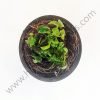
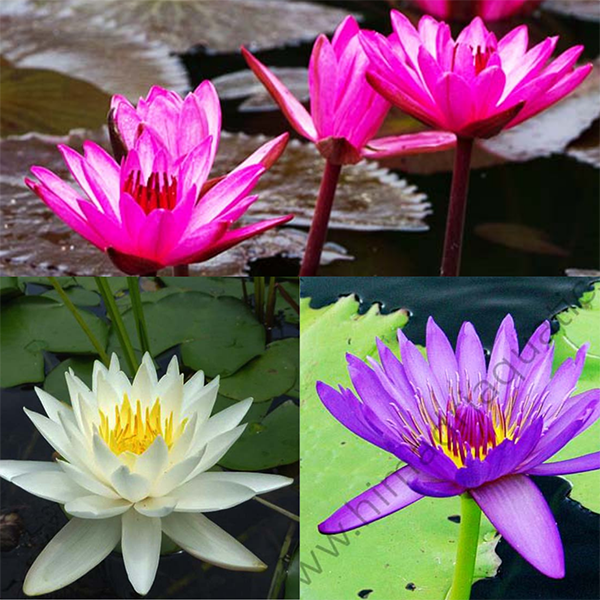

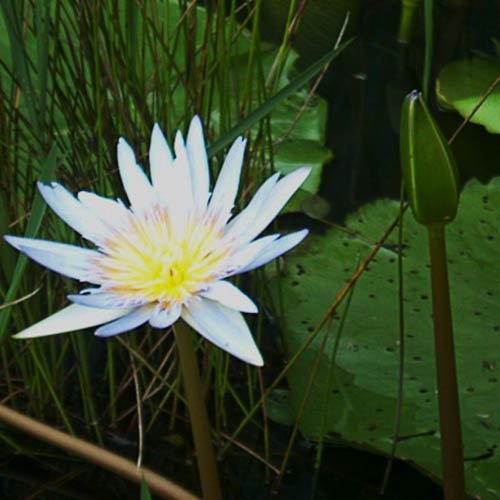
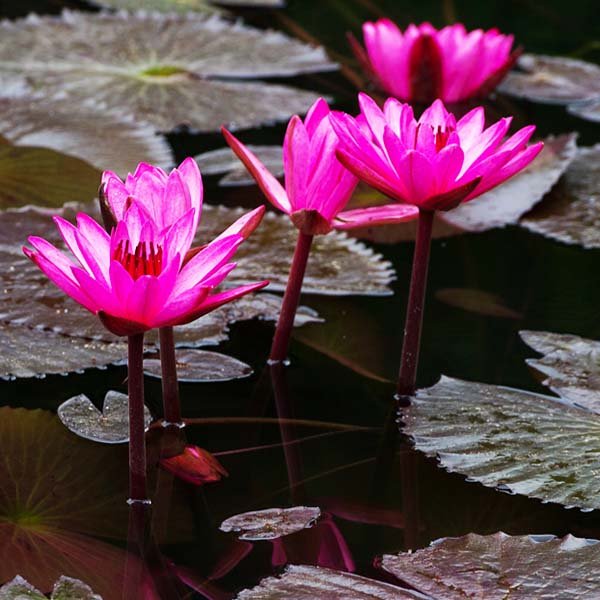
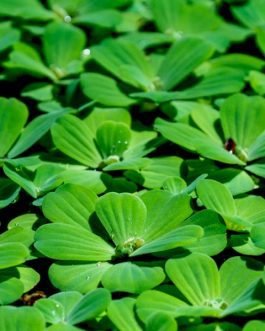

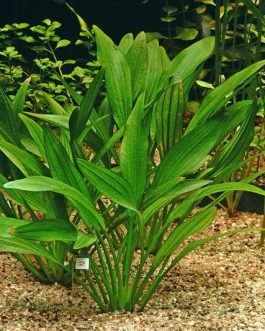
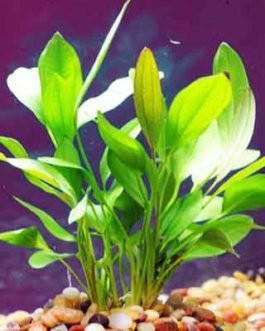
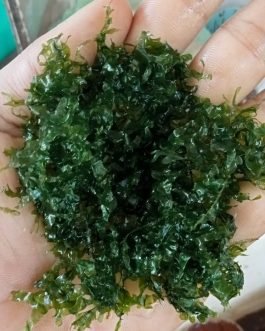

arnold.mathew (verified owner) –
Good one with buds.